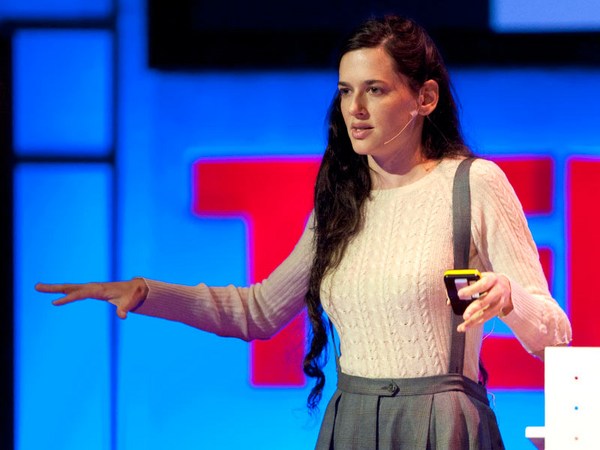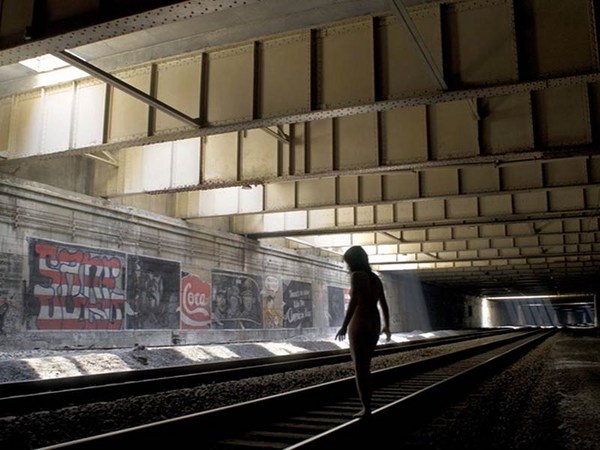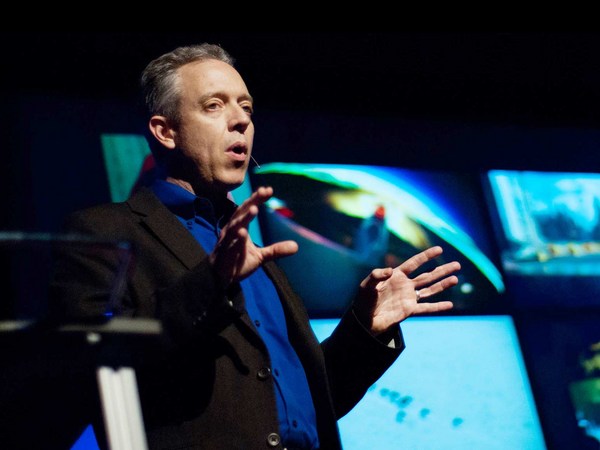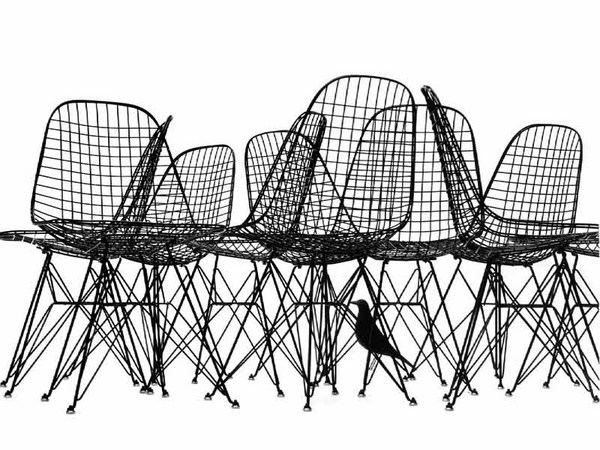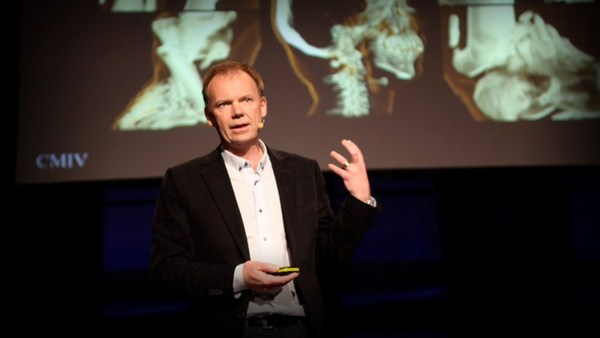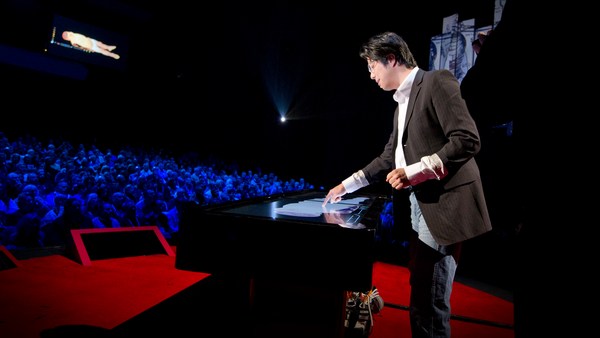So, 120 years ago, Dr. Röntgen X-rayed his wife's hand. Quite why he had to pin her fingers to the floor with her brooch, I'm not sure. It seems a bit extreme to me. That image was the start of the X-ray technology. And I'm still fundamentally using the same principles today. I'm interpreting it in a more contemporary manner.
The first shot I ever did was of a soda can, which was to promote a brand that we all know, so I'm not going to do them any favors by showing you it. But the second shot I did was my shoes I was wearing on the day. And I do really like this shot, because it shows all the detritus that's sort of embedded in the sole of the sneakers. It was just one of those pot-luck things where you get it right first time.
Moving on to something a bit larger, this is an X-ray of a bus. And the bus is full of people. It's actually the same person. It's just one skeleton. And back in the '60s, they used to teach student radiographers to take X-rays, thankfully not on you and I, but on dead people. So, I've still got access to one of these dead people called Frieda; she's falling apart, I'm afraid, because she's very old and fragile. But everyone on that bus is Frieda. And the bus is taken with a cargo-scanning X-ray, which is the sort of machine you have on borders, which checks for contraband and drugs and bombs and things.
Fairly obvious what that is. So, using large-scale objects does sort of create drama because you just don't see X-rays of big things that often. Technology is moving ahead, and these large cargo scanner X-rays that work with the digital system are getting better and better and better. Again though, to make it come alive you need, somehow, to add the human element. And I think the reason this image works, again, is because Frieda is driving the bulldozer. (Laughter)
Quite a difficult brief, make a pair of men's pants look beautiful. But I think the process, in itself, shows how exquisite they are. Fashion -- now, I'm sort of anti-fashion because I don't show the surface, I show what's within. So, the fashionistas don't really like me because it doesn't matter if Kate Moss is wearing it or if I'm wearing it, it looks the same. (Laughter) We all look the same inside, believe me. The creases in the material and the sort of nuances. And I show things for really what they are, what they're made of. I peel back the layers and expose it. And if it's well made I show it, if it's badly made I show it.
And I'm sure Ross can associate that with design. The design comes from within. It's not just Topshop, I get some strange looks when I go out getting my props. Here I was fumbling around in the ladies' underwear department of a department store, almost got escorted from the premises. I live opposite a farm. And this was the runt of the litter, a piglet that died. And what's really interesting is, if you look at the legs, you'll notice that the bones haven't fused. And should that pig have grown, unfortunately it was dead, it would have certainly been dead after I X-rayed it, with the amount of radiation I used anyway. (Laughter) But once the bones had fused together it would have been healthy.
So, that's an empty parka jacket. But I quite love the way it's posed. Nature is my greatest inspiration. And to carry on with a theme that we've already touched with is how nature is related to architecture. If you look at the roof of the Eden Project, or the British library, it's all this honeycomb structure. And I'm sure those architects are inspired, as I am, by what surrounds us, by nature. This, in fact, is a Victoria water lily leaf that floats on the top of a pond. An amaryllis flower looking really three-dimensional. Seaweed, ebbing in the tide. Now, how do I do this, and where do I do this, and all of that sort of thing.
This is my new, purpose-built, X-ray shed. And the door to my X-ray room is made of lead and steel. It weighs 1,250 kilograms and the only exercise I get is opening and closing it. (Laughter) The walls are 700 millimeters thick of solid dense concrete. So, I'm using quite a lot of radiation. A lot more than you'd get in a hospital or a vet's. And there I am. This is a quite high-powered X-ray machine. What's interesting really about X-ray really is, if you think about it, is that that technology is used for looking for cancer or looking for drugs, or looking for contraband or whatever. And I use that sort of technology to create things that are quite beautiful.
So, still working with film, I'm afraid. Technology in X-ray where it's life-size processed, apart from these large cargo-scanning machines, hasn't moved on enough for the quality of the image and the resolution to be good enough for what I want to do with it, which is show my pictures big. So, I have to use a 1980s drum scanner, which was designed in the days when everyone shot photographs on film. They scan each individual X-ray. And this shows how I do my process of same-size X-rays. So, this is, again, my daughter's dress. Still has the tag in it from me buying it, so I can take it back to the shop if she didn't like it. But there are four X-ray plates. You can see them overlapping.
So, when you move forward from something fairly small, a dress which is this size, onto something like that which is done in exactly the same process, you can see that that is a lot of work. In fact, that is three months solid X-raying. There is over 500 separate components. Boeing sent me a 747 in containers. And I sent them back an X-ray. (Laughter) I kid you not.
Okay, so Frieda is my dead skeleton. This, unfortunately, is basically two pictures. One on the extreme right is a photograph of an American footballer. The one on the left is an x-ray. But this time I had to use a real body. Because I needed all the skin tissue to make it look real, to make it look like it was a real athlete. So, here I had to use a recently deceased body. And getting a hold of that was extremely difficult and laborious. But people do donate their bodies to art and science. And when they do, I'm in the queue. So, I like to use them. (Laughter)
The coloring, so coloring adds another level to the X-rays. It makes it more organic, more natural. It's whatever takes my fancy, really. It's not accurately colored to how it is in real life. That flower doesn't come in bright orange, I don't think. But I just like it in bright orange. And also with something technical, like these are DJ decks, it sort of adds another level. It makes a two dimensional image look more three dimensional.
The most difficult things to X-ray, the most technically challenging things to X-ray are the lightest things, the most delicate things. To get the detail in a feather, believe me, if there is anyone out here who knows anything about X-rays, that's quite a challenge. I'm now going to show you a short film, I'll step to the side.
Video: (Music) The thing in there is very dangerous. If you touch that, you could possibly die through radiation poisoning. In my career I've had two exposures to radiation, which is two too many, because it stays with you for life. It's cumulative.
(Music) It has human connotations. The fact that it's a child's toy that we all recognize, but also it looks like it's a robot, and it comes from a sci-fi genus. It's a surprise that it has humanity, but also man-made, future, alien associations. And it's just a bit spooky.
(Music) The bus was done with a cargo-scanning X-ray machine, which is used on the borders between countries, looking for contraband and illegal immigrants. The lorry goes in front of it. And it takes slices of X-rays through the lorry. And that's how this was done. It's actually slice, slice. It's a bit like a CT scanner in a hospital. Slices. And then if you look carefully, there is all little things. He's got headphones on, reading the newspaper, got a hat on, glasses, got a bag. So, these little details help to make it work, make it real.
(Music) The problem with using living people is that to take an X-ray, if I X-ray you, you get exposed to radiation. So, to avoid that -- I have to avoid it somehow -- is I use dead people. Now, that's a variety of things, from recently deceased bodies, to a skeleton that was used by student radiographers to train in taking X-rays of the human body, at different densities.
(Music) I have very high-tech equipment of gloves, scissors and a bucket.
(Music) I will show how the capillary action works, how it feeds, I'll be able to get all the cells inside that stem. Because it transfers food from its roots to its leaves. Look at this monster.
(Music) It's so basic. It just grows wild. That's what I really like about it, the fact that I haven't got to go and buy it, and it hasn't been genetically modified at all. It's just happening. And the X-ray shows how beautiful nature can be. Not that that is particularly beautiful when you look at it with the human eye, the way the leaves form. They're curling back on each other. So the X-ray will show the overlaps in these little corners. The thicker the object, the more radiation it needs, and the more time it needs. The lighter the object, the less radiation. Sometimes you keep the time up, because the time gives you detail. The longer the exposure goes on for, the more detail you get.
(Music) If you look at this, just the tube, it is quite bright. But I could get a bit darker in the tube, but everything else would suffer. So, these leaves at the edge would start to disappear. What I like is how hard the edges are, how sharp. Yeah, I'm quite pleased with it.
(Music) I travel beyond the surface and show something for what it's worth, for what it's really made of, how it really works. But also I find that I've got the benefit of taking away all the surface, which is things that people are used to seeing.
And that's the sort of thing I've been doing. I've got the opportunity now to show you what I'm going to be doing in the future. This is a commercial application of my most recent work. And what's good about this, I think, is that it's like a moment in time, like you've turned around, you've got X-ray vision and you've taken a picture with the X-ray camera. Unfortunately I haven't got X-ray vision. I do dream in X-ray. I see my projects in my sleep. And I know what they're going to look like in X-ray and I'm not far off.
So, what am I doing in the future? Well, this year is the 50th anniversary of Issigonis's Mini, which is one of my favorite cars. So, I've taken it apart, component by component, months and months and months of work. And with this image, I'm going to be displaying it in the Victoria and Albert Museum as a light box, which is actually attached to the car. So, I've got to saw the car in half, down the middle, not an easy task, in itself. And then, so you can get in the driver's side, sit down, and up against you is a wall. And if you get out and walk around to the other side of the car, you see a life-sized light box of the car showing you how it works.
And I'm going to take that idea and apply it to other sort of iconic things from my life. Like, my first computer was a big movement in my life. And I had a Mac Classic. And it's a little box. And I think that would look quite neat as an X-ray. I'm also looking to take my work from the two-dimensional form to a more three-dimensional form. And this is quite a good way of doing it. I'm also working now with X-ray video. So, if you can imagine, some of these flowers, and they're actually moving and growing and you can film that in X-ray, should be quite stunning. But that's it. I'm done. Thank you very much. (Applause)
